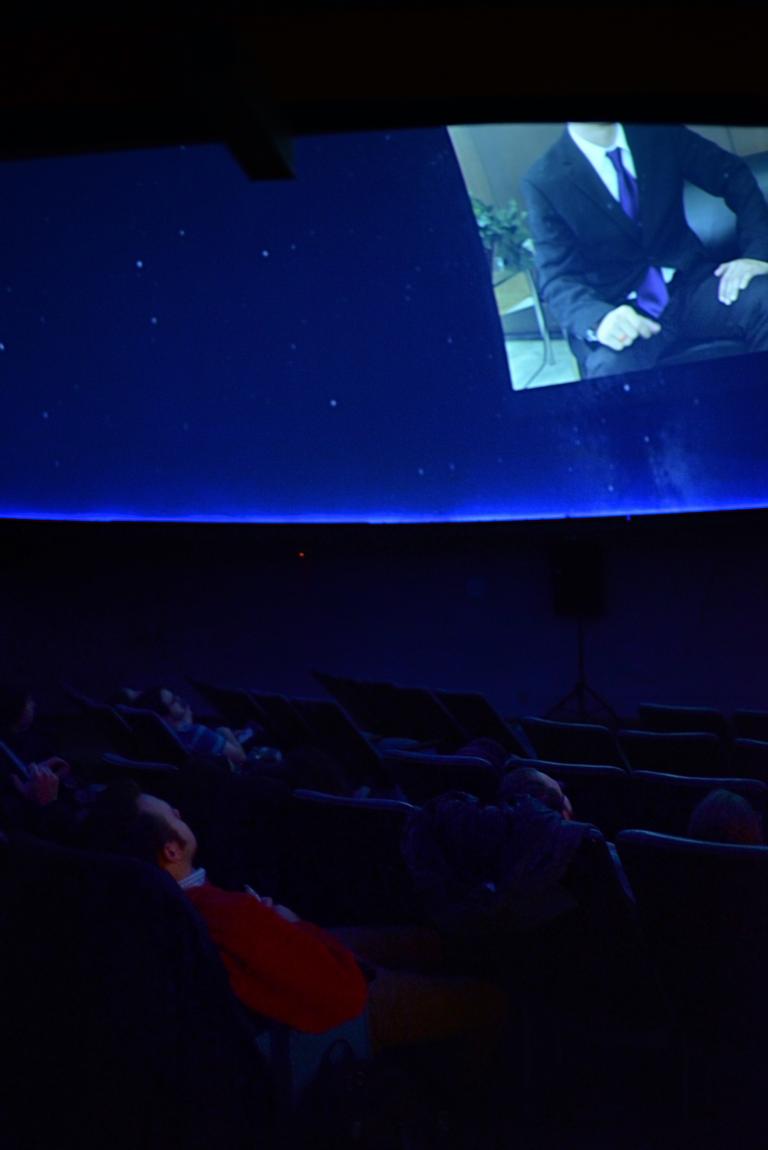Two Digital Arts courses collaborate on projects
calendar icon20 Dec 2016

Lincoln, Neb.--Two Digital Arts Initiative classes in video production and film scoring collaborated on joint projects fall semester to give students a broader experience in creating film projects.
Assistant Professor of Composition Tom Larson’s Film Scoring and Creative Sound Design class worked with Associate Professor of Film Steve Kolbe’s Digital Video Production class on the projects. The final projects included four film projects that were each scored by three different composers. The final projects were shown at the Mueller Planetarium inside Morrill Hall on Dec. 14.
“I thought the final projects turned out very well,” Larson said. “All of the films and scores had a few rough edges but they were really just technical issues. Considering our logistical and time constraints, those were bound to happen. But creatively and conceptually, I was very happy with the final projects.”
Kolbe’s class had three film projects throughout the semester. Both classes met together on those projects, which included pre-planning and viewing/listening to the completed projects. The rest of the time, the classes worked on other assignments independently.
“I think it is very important for film composers to get some training in collaborating with creative folks from a different discipline,” Larson said. “I told my students the first week that we are one part, albeit an important one, of a many-faceted project. Our job is to make the end result better, not to showcase our talent. We are not the bride at the reception! I hope the collaboration of these two courses was a good experience in that regard.”
Chas Bogatz, an advertising and public relations senior in the College of Journalism and Mass Communications, was in the Film Scoring and Creative Sound design class and said he had never done anything like this before.
“I got a lot out of the class,” Bogatz said. “Notably, the class taught me to be sensitive in my compositions to what the viewer is looking at. It's a humbling thing to realize you have to turn your own composition down for the betterment of the film. Pride can take away a lot from film aesthetic—and this reflects into real life. Many times, we love a character that doesn't work, or a work that is unnecessary, or a song that doesn't fit. We take our creative efforts personally. Film scoring is the subtle talent of learning when to fill in, and learning when to back away.”
Students in the film scoring class worked on several different films throughout the semester.
“We took films off Vimeo or YouTube and rescored them, and we scored original works from the film students,” Bogatz said. “In one, they were given a script from a real movie, and they could act it out however they wished. In another, they re-shot a scene from a movie exactly. The last was a completely original work. We scored each.”
Mackenzie Anderson, a child, youth and family studies senior in the College of Education and Human Sciences from Houston, Texas, was in the video production class.
“I loved working with the scoring class,” she said. “It was fun to see their different creations and compare them. Normally our one video would be scored by three students, so it was interesting to hear the differences. I strongly believe the music in a video can totally transform the entire movie.”
She was pleased with her final project, a film called “Elizabeth,” that was a scary movie with a plot twist in the end.
“It was fun to see our creation because, from the beginning of the year, we were coming up with ideas for this final,” she said. “I especially enjoyed it because our video was my original story, so it was fun to see it come to life.”
Bogatz was one of the three composers who scored “Elizabeth.”
“Horror scores have to trick the audience into comfort, and then rip that comfort out from under them,” he said. “Musically, this is difficult. I used a number of tricks, including inhuman sounds and uncomfortable loops that helped enhance the tension.”
Bogatz, who hopes to work in an advertising agency or an in-house marketing team, said the experience of this class helped him.
“I left this class with a greater understanding of teamwork and creative humility,” he said. “As a part-time musician, learning how to take one’s creative efforts not personally is fundamental to success and cohesion within a group. In an advertising team, many of my ideas for tag lines, radio spots or commercial ideas will be shot down or neglected. This class taught me that rejection of a work is not a reflection on character. As we develop creative entities, they go through growing pains until they establish a personality of their own.”
Anderson said she received a lot of professional knowledge for her future in broadcasting.
“We learned multiple software, so I believe this class better prepared me for what I hope to do after graduation and in my internship with a video production studio next semester,” she said. “I would recommend this class for anyone remotely interested in studying broadcasting or love it as a hobby.”